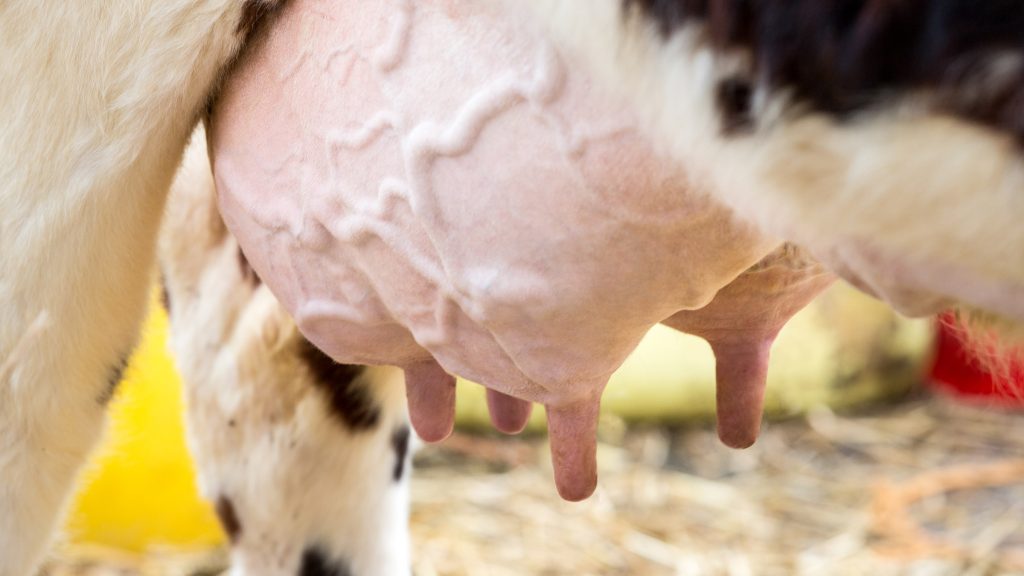Bovine mastitis, which is an inflammation of the udder caused by multiple factors, including bacterial infection or trauma, can lead to abnormal and decreased milk production. It is still one of the most common problems that continues to plague the dairy industry.
Mastitis is one of the main reasons producers cull dairy cows, and the treatment of clinical cases of mastitis is not only expensive for dairy farmers, who must carry higher labour and treatment costs while at the same time discarding milk, but it also increases the risk of antibiotic residue in bulk tanks. Mastitis can also adversely affect the reproductive performance of dairy cows.
On average, it can take significantly longer to get cows pregnant that have had a case of mastitis. The problem is that, aside from the pain that cows suffering from mastitis have to endure, even mild cases impact milk quality due to an increase in inflammatory cells (somatic cells) in the milk. More severe cases can radically impact milk production and extremely severe cases can result in death.
“Traditionally there has been a high level of reliance on antibiotics to treat and prevent mastitis,” says Dr. Chantelle Erwee, Technical Manager: Ruminants, at Zoetis South Africa, a global animal health company.
“The possible fatal consequences and general cost of treating mastitis warrants the importance of an appropriate mastitis prevention and control programme. Zoetis has introduced innovative non-antibiotic solutions that can assist farmers in the prevention of mastitis,” says Dr Erwee.
Unpacking the myths of mastitis
“The dry period is crucial and can affect the occurrence of clinical mastitis in the following lactation,” says Dr Erwee. “Studies have estimated that between 52% to 60% of clinical mastitis cases that occurred in early lactation actually originated in the dry period. These infections usually remain dormant until the first three months of lactation, when they cause clinical and sub-clinical mastitis.”
Once mastitis occurs, the costs can pile up. The treatment of mastitis itself isn’t high, but there are multiple hidden costs that add up, including lactation milk yield loss, which has been shown to be an average of 375 kg/lactation after a clinical mastitis incidence. Milk discard due to the withdrawal period of medications used can also have a lasting impact and there are always potential death losses. “One study in South Africa, published in 2016, found the total cost of mastitis per cow per year to be almost R 2 000. This will be higher today,” says Dr Erwee.
According to Dr Erwee, one major way in which pathogens gain access to the udder is via the teat canal. “Soon after drying off, a keratin plug forms in the teat canal, as part of the cow’s natural defense mechanisms,” says Dr Erwee. “This keratin plug then prevents access to the mammary gland by physically blocking the entrance of mastitis-causing pathogens. The rate at which this keratin plug forms, differs between individual cows. For example, high producers tend to have delayed closure. If there is any delay in the formation of this natural keratin plug, cows are at higher risk of developing mastitis caused by an environmental pathogen.” Due to the delayed and sometimes incomplete keratin plug formation, teat sealants were developed as an effective solution.
Teat sealants play an important role during the dry period by mimicking this physical barrier function of the natural keratin plug. Studies performed in the United Kingdom, Australia, New Zealand, the United States and Canada have shown that the use of internal teat sealants during the dry period, can effectively prevent or reduce new intramammary infections and clinical mastitis in the next lactation.
“Use of an internal teat sealant in combination with antibiotic dry cow therapy is being used around the world in places like Australia, North America, Europe and New Zealand, however it is regarded as a relatively new concept in South Africa, which is something we are actively working towards changing.”
Focusing on prevention
Control of mastitis is based on a sound mastitis management programme that should include at least some of the following practices:
- Proper use of a functional milking machine with appropriate milking machine maintenance.
- Teat dipping, pre- and post-milking with an effective, approved teat dip.
- Early treatment of clinical cases.
- Dry cow therapy, if appropriate, at the end of lactation with a dry cow mastitis product.
- Use of an internal teat sealant, such as Orbeseal® from Zoetis.
- Culling of cows with chronic mastitis.
- Appropriate vaccination with a Gram-negative core antigen vaccine to reduce coliform infections.
“Prevention is always better than cure,” says Dr Erwee. “Not only is the health and well-being of dairy cows protected with a good preventative mastitis management programme, but milk production is kept stable, the use of antibiotics is limited, and milk quality is maintained.”
Source: Orbeseal®









